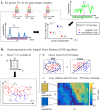Forecasting dengue fever in Brazil: An assessment of climate conditions
- PMID: 31393908
- PMCID: PMC6687106
- DOI: 10.1371/journal.pone.0220106
Forecasting dengue fever in Brazil: An assessment of climate conditions
Abstract
Local climate conditions play a major role in the biology of the Aedes aegypti mosquito, the main vector responsible for transmitting dengue, zika, chikungunya and yellow fever in urban centers. For this reason, a detailed assessment of periods in which changes in climate conditions affect the number of human cases may improve the timing of vector-control efforts. In this work, we develop new machine-learning algorithms to analyze climate time series and their connection to the occurrence of dengue epidemic years for seven Brazilian state capitals. Our method explores the impact of two key variables-frequency of precipitation and average temperature-during a wide range of time windows in the annual cycle. Our results indicate that each Brazilian state capital considered has its own climate signatures that correlate with the overall number of human dengue-cases. However, for most of the studied cities, the winter preceding an epidemic year shows a strong predictive power. Understanding such climate contributions to the vector's biology could lead to more accurate prediction models and early warning systems.
Conflict of interest statement
The authors have declared that no competing interests exist.
Figures






References
-
- World Health Organization. dengue and severe dengue. WHO Factsheet No 117. Geneva. 2015; Available from: http://www.who.int/mediacentre/factsheets/fs117/en/.
-
- Figueredo LTM. Dengue in Brazil: Past, Present and Future Perspectives. dengue Bulletin. 2003; 27, 25–33.
Publication types
MeSH terms
LinkOut - more resources
Full Text Sources
Medical

